
Chapter 13 Maxwell's Equations and Electromagnetic Waves 13.1 The Displacement Current................. 13-3 13.2 Gauss's Law for Magnetism........ 13-5 13.3 Maxwell's Equations............... 13-6 13.4 Plane Traveling Electromagnetic Waves....... 13-7 13.4.1 One-Dimensional Wave Equation... 13-12 13.4.2 Gaussian One Dimensional Wave Pulse 13-13 13.5 Standing Electromagnetic Waves.................. 13-18 13.6 Poynting Vector… 13-21 Example 13.1:Solar Constant................ 13-23 Example 13.2:Intensity of a Standing Wave............ 13-24 13.6.1 Energy Transport...... 13-25 13.6.2 Power flow in a Solenoid with Changing Current 13-26 13.7 Momentum and Radiation Pressure...................... 13-28 13.8 Production of Electromagnetic Waves........... 13-29 13.8.1 Electric Dipole Radiation Movie....... 13-31 13.8.2 Another Electric Dipole Radiation Movie..... 13-31 13.8.3 Radiation From a Quarter-Wave Antenna Animation...............13-32 13.8.4 Plane Waves.… 13-32 13.8.5 Sinusoidal Electromagnetic Wave.................. 13-37 13.9 Summary 13-39 13.10 Appendix:Reflection of Electromagnetic Waves at Conducting Surfaces..13-41 13.11 Problem-Solving Strategy:Traveling Electromagnetic Waves..........13-46 13.12 Solved Problems............ 13-47 13.12.1 plane Electromagnetic Wave. 13-47 13.12.2 One-Dimensional Wave Equation......... 13-48 13.12.3 Poynting Vector of a Charging Capacitor.... 13-49 13-1
13-1 Chapter 13 Maxwell’s Equations and Electromagnetic Waves 13.1 The Displacement Current.............................................................................. 13-3 13.2 Gauss’s Law for Magnetism........................................................................... 13-5 13.3 Maxwell’s Equations ...................................................................................... 13-6 13.4 Plane Traveling Electromagnetic Waves........................................................ 13-7 13.4.1 One-Dimensional Wave Equation ......................................................... 13-12 13.4.2 Gaussian One Dimensional Wave Pulse................................................ 13-13 13.5 Standing Electromagnetic Waves................................................................. 13-18 13.6 Poynting Vector............................................................................................ 13-21 Example 13.1: Solar Constant.............................................................................. 13-23 Example 13.2: Intensity of a Standing Wave....................................................... 13-24 13.6.1 Energy Transport ................................................................................... 13-25 13.6.2 Power flow in a Solenoid with Changing Current................................. 13-26 13.7 Momentum and Radiation Pressure.............................................................. 13-28 13.8 Production of Electromagnetic Waves ......................................................... 13-29 13.8.1 Electric Dipole Radiation Movie ........................................................... 13-31 13.8.2 Another Electric Dipole Radiation Movie ............................................. 13-31 13.8.3 Radiation From a Quarter-Wave Antenna Animation........................... 13-32 13.8.4 Plane Waves........................................................................................... 13-32 13.8.5 Sinusoidal Electromagnetic Wave ......................................................... 13-37 13.9 Summary....................................................................................................... 13-39 13.10 Appendix: Reflection of Electromagnetic Waves at Conducting Surfaces.. 13-41 13.11 Problem-Solving Strategy: Traveling Electromagnetic Waves.................... 13-46 13.12 Solved Problems ........................................................................................... 13-47 13.12.1 Plane Electromagnetic Wave................................................................. 13-47 13.12.2 One-Dimensional Wave Equation......................................................... 13-48 13.12.3 Poynting Vector of a Charging Capacitor............................................. 13-49
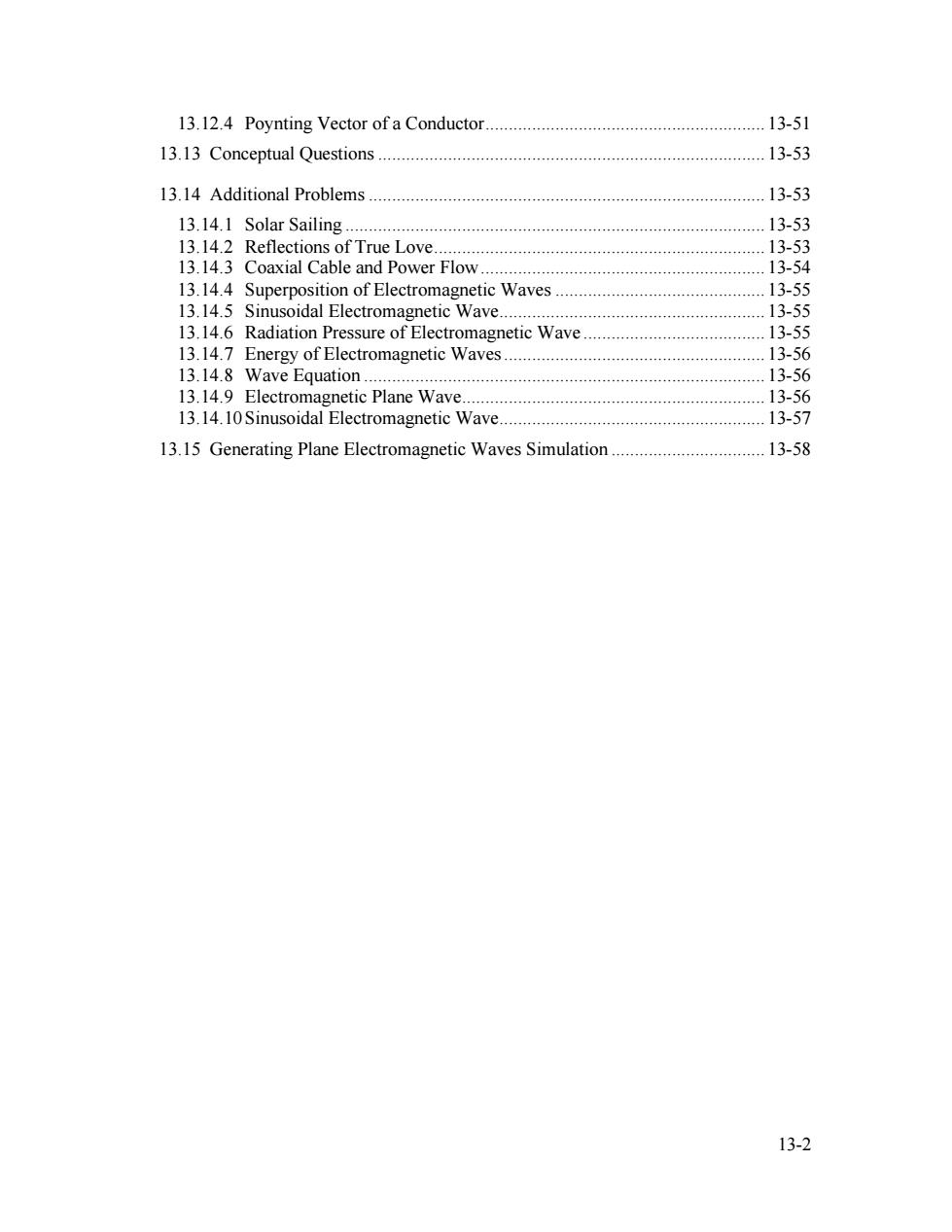
13.12.4 Poynting Vector of a Conductor. 13-51 13.13 Conceptual Questions13-53 13.14 Additional Problems. 13-53 13.14.I Solar Sailing. 3-53 13.142 Reflections ofTrue Love.13-53 13.14.3 Coaxial Cable and Power Flow..... 13-54 13.14.4 Superposition of Electromagnetic Waves............................................1.3-55 13.14.5 Sinusoidal Electromagnetic Wave........ 13-55 13.14.6 Radiation Pressure of Electromagnetic Wave................................... 13-55 13.14.7 Energy of Electromagnetic Waves..... 13-56 13.14.8 Wave Equation. 13-56 13.14.9 Electromagnetic Plane Wave........................ 13-56 13.14.10 Sinusoidal Electromagnetic Wave........................ 13-57 13.15 Generating Plane Electromagnetic Waves Simulation............. 13-58 13-2
13-2 13.12.4 Poynting Vector of a Conductor............................................................ 13-51 13.13 Conceptual Questions ................................................................................... 13-53 13.14 Additional Problems ..................................................................................... 13-53 13.14.1 Solar Sailing .......................................................................................... 13-53 13.14.2 Reflections of True Love....................................................................... 13-53 13.14.3 Coaxial Cable and Power Flow............................................................. 13-54 13.14.4 Superposition of Electromagnetic Waves ............................................. 13-55 13.14.5 Sinusoidal Electromagnetic Wave......................................................... 13-55 13.14.6 Radiation Pressure of Electromagnetic Wave ....................................... 13-55 13.14.7 Energy of Electromagnetic Waves........................................................ 13-56 13.14.8 Wave Equation ...................................................................................... 13-56 13.14.9 Electromagnetic Plane Wave................................................................. 13-56 13.14.10Sinusoidal Electromagnetic Wave......................................................... 13-57 13.15 Generating Plane Electromagnetic Waves Simulation ................................. 13-58
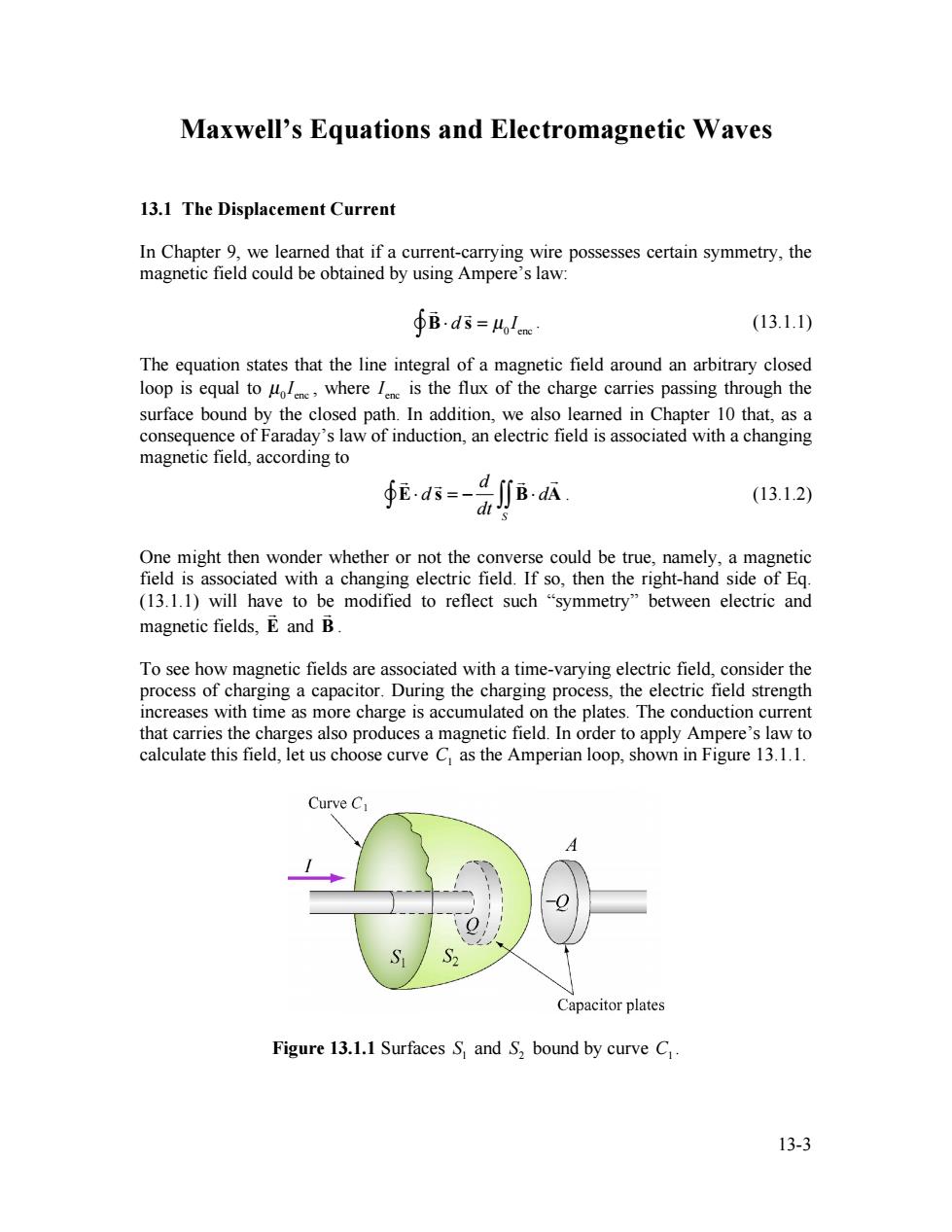
Maxwell's Equations and Electromagnetic Waves 13.1 The Displacement Current In Chapter 9,we learned that if a current-carrying wire possesses certain symmetry,the magnetic field could be obtained by using Ampere's law: Bds=Molcne (13.1.1) The equation states that the line integral of a magnetic field around an arbitrary closed loop is equal to ol where I is the flux of the charge carries passing through the surface bound by the closed path.In addition,we also learned in Chapter 10 that,as a consequence of Faraday's law of induction,an electric field is associated with a changing magnetic field,according to (13.1.2) One might then wonder whether or not the converse could be true,namely,a magnetic field is associated with a changing electric field.If so,then the right-hand side of Eq. (13.1.1)will have to be modified to reflect such "symmetry"between electric and magnetic fields,E and B To see how magnetic fields are associated with a time-varying electric field,consider the process of charging a capacitor.During the charging process,the electric field strength increases with time as more charge is accumulated on the plates.The conduction current that carries the charges also produces a magnetic field.In order to apply Ampere's law to calculate this field,let us choose curve C as the Amperian loop,shown in Figure 13.1.1. Curve C Capacitor plates Figure 13.1.1 Surfaces S and S,bound by curve C 13-3
13-3 Maxwell’s Equations and Electromagnetic Waves 13.1 The Displacement Current In Chapter 9, we learned that if a current-carrying wire possesses certain symmetry, the magnetic field could be obtained by using Ampere’s law: ! B! d ! s "" = µ0 Ienc . (13.1.1) The equation states that the line integral of a magnetic field around an arbitrary closed loop is equal to 0 enc µ I , where enc I is the flux of the charge carries passing through the surface bound by the closed path. In addition, we also learned in Chapter 10 that, as a consequence of Faraday’s law of induction, an electric field is associated with a changing magnetic field, according to ! E! d ! s "" = # d dt ! B! d ! A S "" . (13.1.2) One might then wonder whether or not the converse could be true, namely, a magnetic field is associated with a changing electric field. If so, then the right-hand side of Eq. (13.1.1) will have to be modified to reflect such “symmetry” between electric and magnetic fields, E ! and B ! . To see how magnetic fields are associated with a time-varying electric field, consider the process of charging a capacitor. During the charging process, the electric field strength increases with time as more charge is accumulated on the plates. The conduction current that carries the charges also produces a magnetic field. In order to apply Ampere’s law to calculate this field, let us choose curve C1 as the Amperian loop, shown in Figure 13.1.1. Figure 13.1.1 Surfaces 1 S and 2 S bound by curve C1
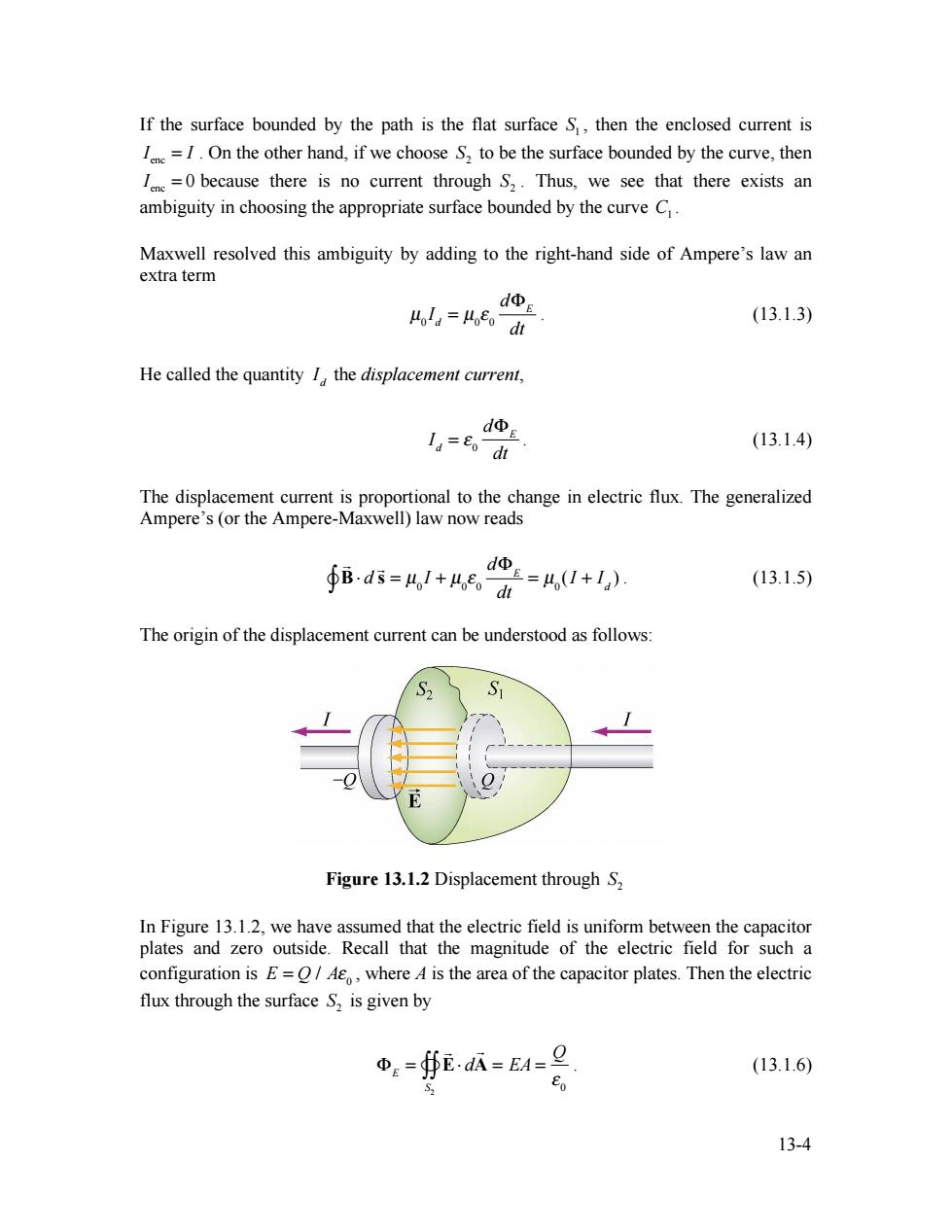
If the surface bounded by the path is the flat surface S,then the enclosed current is I=1.On the other hand,if we choose 2 to be the surface bounded by the curve,then =0 because there is no current through S2.Thus,we see that there exists an ambiguity in choosing the appropriate surface bounded by the curve C. Maxwell resolved this ambiguity by adding to the right-hand side of Ampere's law an extra term dΦE ola=odi (13.1.3) He called the quantity I the displacement current, d Ia=Eo dt (13.1.4) The displacement current is proportional to the change in electric flux.The generalized Ampere's (or the Ampere-Maxwell)law now reads ∮Bd5=/+4,e。 d=4,I+l) (13.1.5) The origin of the displacement current can be understood as follows: S2 Figure 13.1.2 Displacement through S2 In Figure 13.1.2,we have assumed that the electric field is uniform between the capacitor plates and zero outside.Recall that the magnitude of the electric field for such a configuration is E=/A,where A is the area of the capacitor plates.Then the electric flux through the surface S,is given by ΦE=∯EaA=EA=旦 (13.1.6) S2 13-4
13-4 If the surface bounded by the path is the flat surface 1 S , then the enclosed current is enc I = I . On the other hand, if we choose 2 S to be the surface bounded by the curve, then enc I = 0 because there is no current through 2 S . Thus, we see that there exists an ambiguity in choosing the appropriate surface bounded by the curve C1 . Maxwell resolved this ambiguity by adding to the right-hand side of Ampere’s law an extra term µ0 Id = µ0 ! 0 d"E dt . (13.1.3) He called the quantity Id the displacement current, Id = ! 0 d"E dt . (13.1.4) The displacement current is proportional to the change in electric flux. The generalized Ampere’s (or the Ampere-Maxwell) law now reads ! B! d ! s "" = µ0 I + µ0 # 0 d$E dt = µ0 (I + Id ) . (13.1.5) The origin of the displacement current can be understood as follows: Figure 13.1.2 Displacement through 2 S In Figure 13.1.2, we have assumed that the electric field is uniform between the capacitor plates and zero outside. Recall that the magnitude of the electric field for such a configuration is E = Q / A! 0 , where A is the area of the capacitor plates. Then the electric flux through the surface 2 S is given by !E = ! E" d ! A S2 "## = EA = Q $ 0 . (13.1.6)
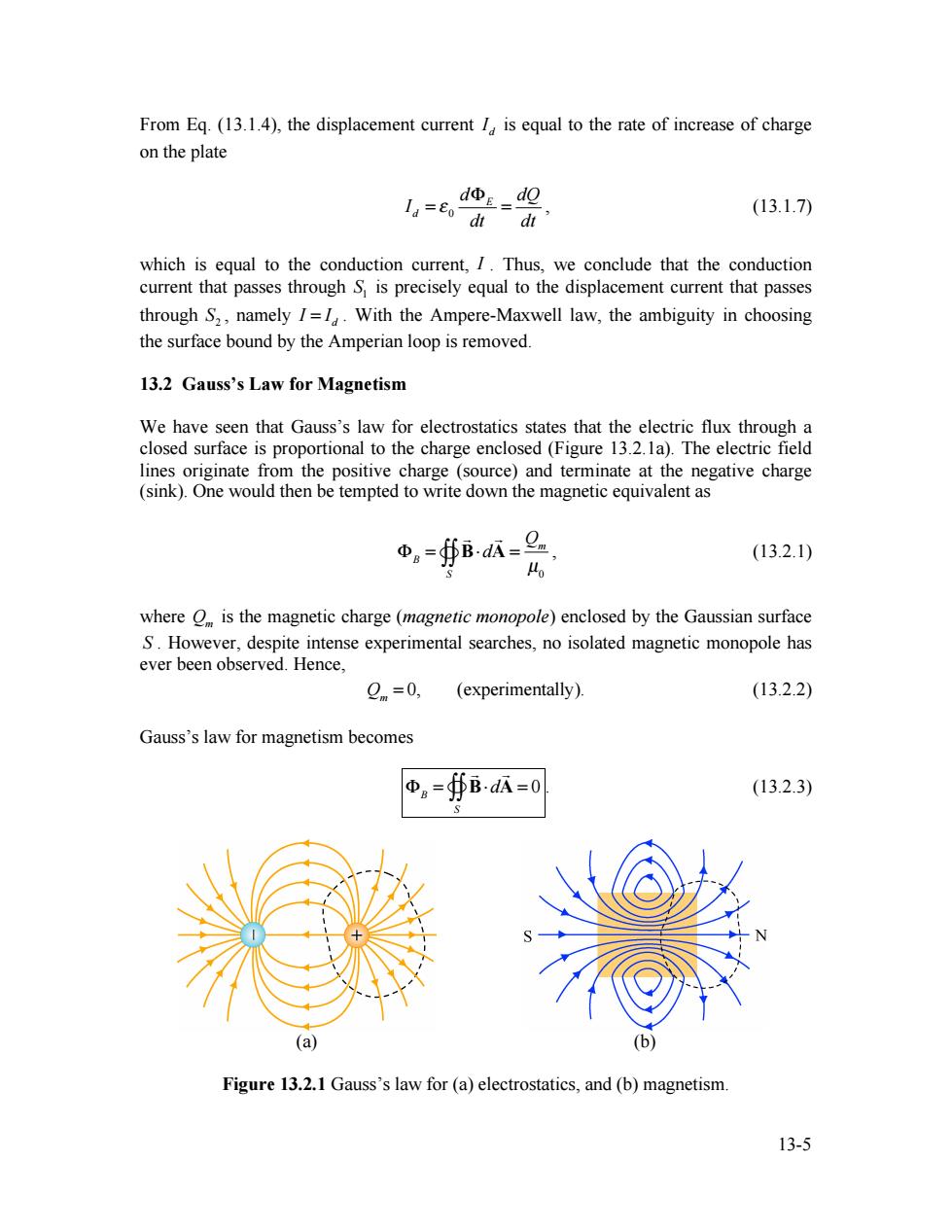
From Eq.(13.1.4),the displacement current I,is equal to the rate of increase of charge on the plate ,dΦE=d Ia=8o di di' (13.1.7) which is equal to the conduction current,I.Thus,we conclude that the conduction current that passes through S is precisely equal to the displacement current that passes through S2,namely I=1.With the Ampere-Maxwell law,the ambiguity in choosing the surface bound by the Amperian loop is removed. 13.2 Gauss's Law for Magnetism We have seen that Gauss's law for electrostatics states that the electric flux through a closed surface is proportional to the charge enclosed(Figure 13.2.1a).The electric field lines originate from the positive charge (source)and terminate at the negative charge (sink).One would then be tempted to write down the magnetic equivalent as Φ。=BadA= (13.2.1) where O is the magnetic charge (magnetic monopole)enclosed by the Gaussian surface S.However,despite intense experimental searches,no isolated magnetic monopole has ever been observed.Hence, Qm=0, (experimentally). (13.2.2) Gauss's law for magnetism becomes 中。=∯BdA=0 (13.2.3) (a) Figure 13.2.1 Gauss's law for (a)electrostatics,and (b)magnetism 13-5
13-5 From Eq. (13.1.4), the displacement current d I is equal to the rate of increase of charge on the plate 0 E d d dQ I dt dt ! " = = , (13.1.7) which is equal to the conduction current, I . Thus, we conclude that the conduction current that passes through 1 S is precisely equal to the displacement current that passes through 2 S , namely d I = I . With the Ampere-Maxwell law, the ambiguity in choosing the surface bound by the Amperian loop is removed. 13.2 Gauss’s Law for Magnetism We have seen that Gauss’s law for electrostatics states that the electric flux through a closed surface is proportional to the charge enclosed (Figure 13.2.1a). The electric field lines originate from the positive charge (source) and terminate at the negative charge (sink). One would then be tempted to write down the magnetic equivalent as !B = ! B"d ! A S "## = Qm µ0 , (13.2.1) where Qm is the magnetic charge (magnetic monopole) enclosed by the Gaussian surface S . However, despite intense experimental searches, no isolated magnetic monopole has ever been observed. Hence, Qm = 0, (experimentally). (13.2.2) Gauss’s law for magnetism becomes !B = ! B"d ! A S "## = 0 . (13.2.3) (a) (b) Figure 13.2.1 Gauss’s law for (a) electrostatics, and (b) magnetism
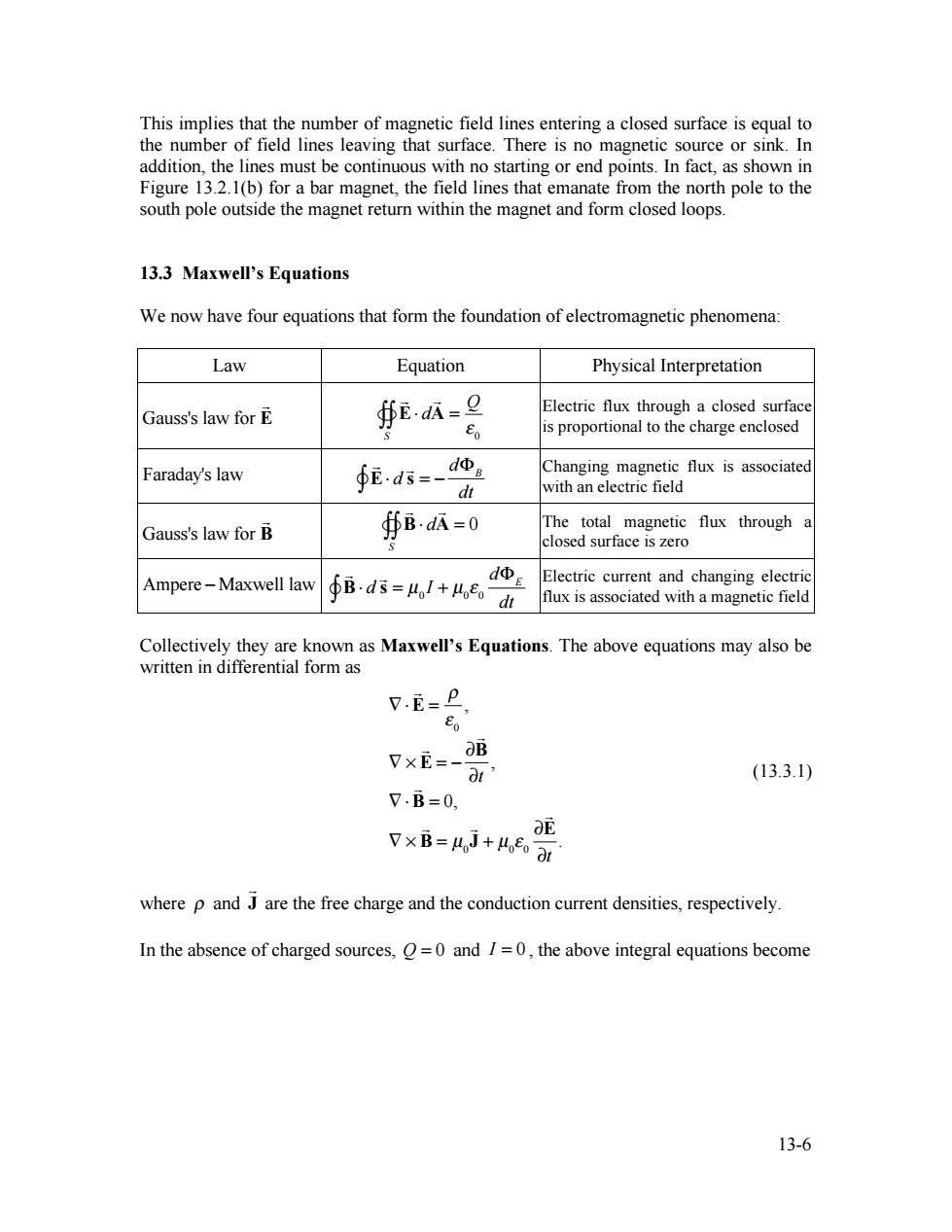
This implies that the number of magnetic field lines entering a closed surface is equal to the number of field lines leaving that surface.There is no magnetic source or sink.In addition,the lines must be continuous with no starting or end points.In fact,as shown in Figure 13.2.1(b)for a bar magnet,the field lines that emanate from the north pole to the south pole outside the magnet return within the magnet and form closed loops. 13.3 Maxwell's Equations We now have four equations that form the foundation of electromagnetic phenomena: Law Equation Physical Interpretation Gauss's law for E ∯E.A= Electric flux through a closed surface Eo is proportional to the charge enclosed Faraday's law ∮Ed5=-Φ2 Changing magnetic flux is associated with an electric field Gauss's law for B ∯B=0 The total magnetic flux through a closed surface is zero Ampere-Maxwell law dΦE fB.ds=1+4e。di Electric current and changing electric flux is associated with a magnetic field Collectively they are known as Maxwell's Equations.The above equations may also be written in differential form as V.E=P Eo P×E=-那 (13.3.1) 7.B=0, V×B=4,J+ea where p and J are the free charge and the conduction current densities,respectively. In the absence of charged sources,O=0 and I=0,the above integral equations become 13-6
13-6 This implies that the number of magnetic field lines entering a closed surface is equal to the number of field lines leaving that surface. There is no magnetic source or sink. In addition, the lines must be continuous with no starting or end points. In fact, as shown in Figure 13.2.1(b) for a bar magnet, the field lines that emanate from the north pole to the south pole outside the magnet return within the magnet and form closed loops. 13.3 Maxwell’s Equations We now have four equations that form the foundation of electromagnetic phenomena: Law Equation Physical Interpretation Gauss's law for E ! ! E! d ! A S """ = Q # 0 Electric flux through a closed surface is proportional to the charge enclosed Faraday's law ! E! d ! s = " d#B dt "$ Changing magnetic flux is associated with an electric field Gauss's law for B ! ! B! d ! A S """ = 0 The total magnetic flux through a closed surface is zero Ampere ! Maxwell law ! B! d ! s = µ0 I + µ0 " 0 d#E dt "$ Electric current and changing electric flux is associated with a magnetic field Collectively they are known as Maxwell’s Equations. The above equations may also be written in differential form as ! " ! E = # $ 0 , ! % ! E = & ' ! B 't , ! " ! B = 0, ! % ! B = µ0 ! J + µ0 $ 0 ' ! E 't . (13.3.1) where ! and J ! are the free charge and the conduction current densities, respectively. In the absence of charged sources, Q = 0 and I = 0 , the above integral equations become
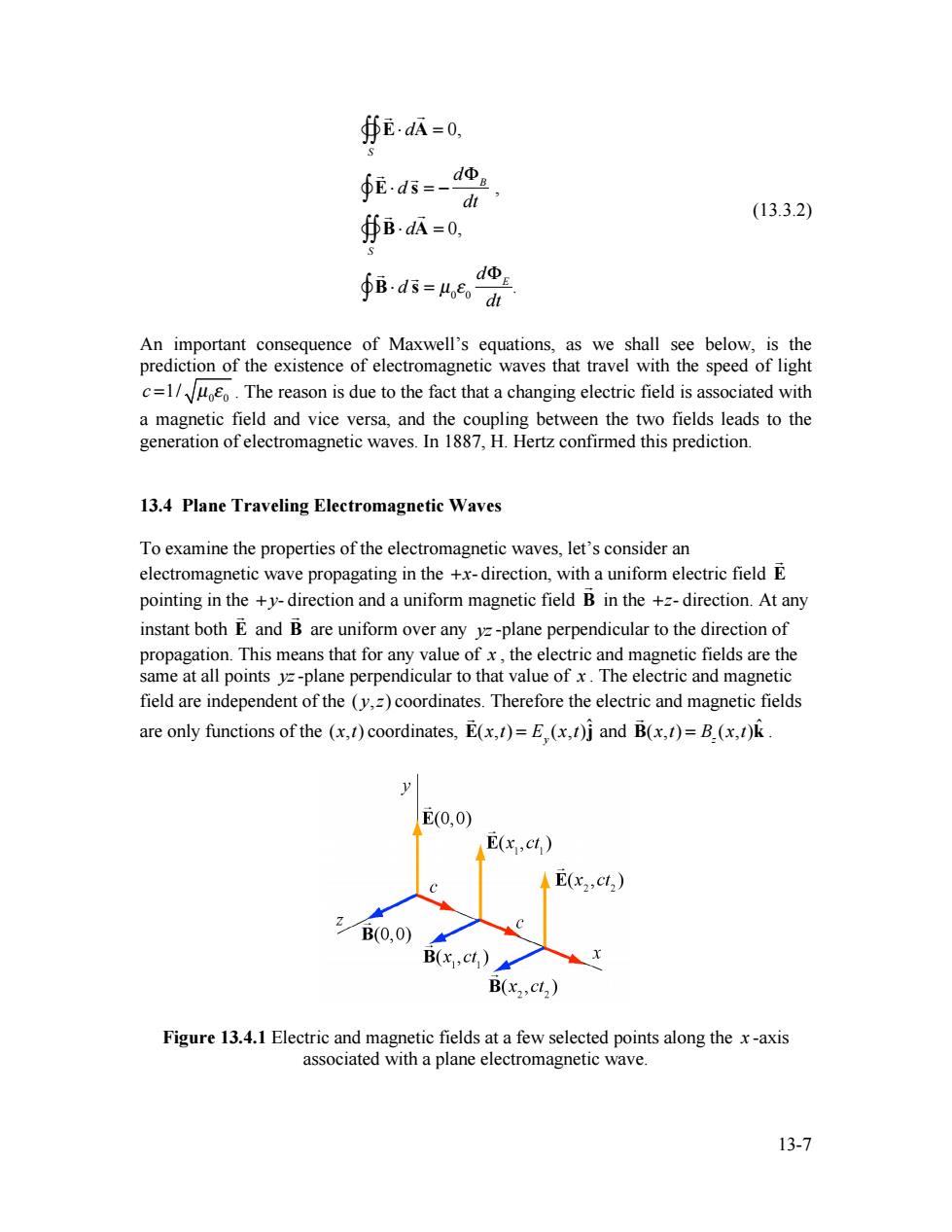
∯EdA=0, ∮2ds= dΦB dt (13.3.2) ∯B.dA=0, dΦE ∮B-ds=4edh An important consequence of Maxwell's equations,as we shall see below,is the prediction of the existence of electromagnetic waves that travel with the speed of light c=1/.The reason is due to the fact that a changing electric field is associated with a magnetic field and vice versa,and the coupling between the two fields leads to the generation of electromagnetic waves.In 1887,H.Hertz confirmed this prediction. 13.4 Plane Traveling Electromagnetic Waves To examine the properties of the electromagnetic waves,let's consider an electromagnetic wave propagating in the +x-direction,with a uniform electric field E pointing in the +y-direction and a uniform magnetic field B in the +z-direction.At any instant both E and B are uniform over any yz-plane perpendicular to the direction of propagation.This means that for any value of x,the electric and magnetic fields are the same at all points yz-plane perpendicular to that value ofx.The electric and magnetic field are independent of the (y,z)coordinates.Therefore the electric and magnetic fields are only functions of the (x,t)coordinates,E(x,t)=E (x,t)j and B(x,t)=B.(x,t)k E(0,0) E(x,ct) E(x2,ct2) B(0,0) B(x.cl) B(x,,ct) Figure 13.4.1 Electric and magnetic fields at a few selected points along the x-axis associated with a plane electromagnetic wave. 13-7
13-7 ! E! d ! A S """ = 0, ! E! d ! s = # d$B dt #" , ! B! d ! A S """ = 0, ! B! d ! s = µ0 % 0 d$E dt #" . (13.3.2) An important consequence of Maxwell’s equations, as we shall see below, is the prediction of the existence of electromagnetic waves that travel with the speed of light 0 0 c =1/ µ ! . The reason is due to the fact that a changing electric field is associated with a magnetic field and vice versa, and the coupling between the two fields leads to the generation of electromagnetic waves. In 1887, H. Hertz confirmed this prediction. 13.4 Plane Traveling Electromagnetic Waves To examine the properties of the electromagnetic waves, let’s consider an electromagnetic wave propagating in the +x- direction, with a uniform electric field E ! pointing in the + y- direction and a uniform magnetic field B ! in the +z- direction. At any instant both E ! and B ! are uniform over any yz-plane perpendicular to the direction of propagation. This means that for any value of x , the electric and magnetic fields are the same at all points yz-plane perpendicular to that value of x . The electric and magnetic field are independent of the ( y,z) coordinates. Therefore the electric and magnetic fields are only functions of the (x,t) coordinates, ! E(x,t) = E y (x,t)ˆ j and ! B(x,t) = Bz (x,t)kˆ . Figure 13.4.1 Electric and magnetic fields at a few selected points along the x -axis associated with a plane electromagnetic wave
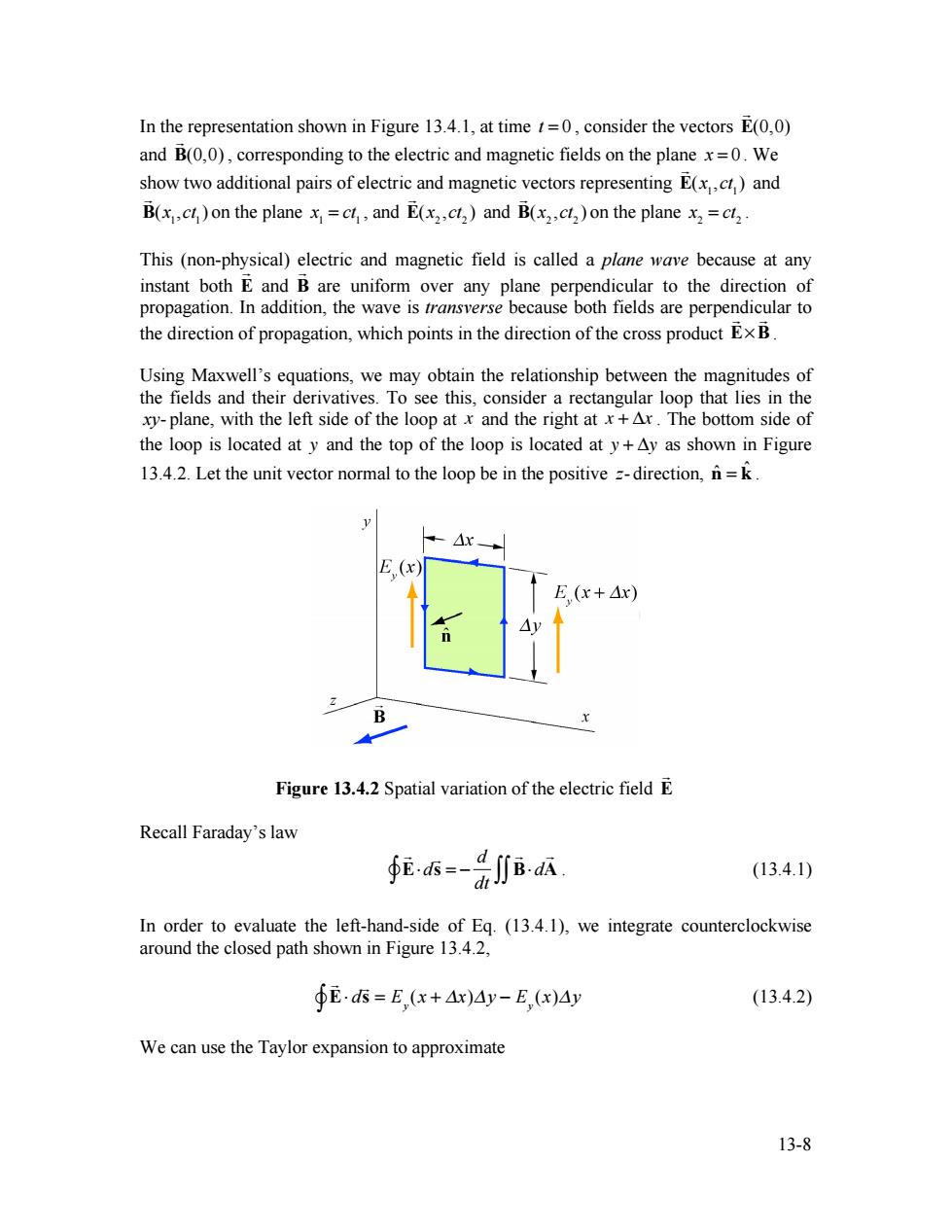
In the representation shown in Figure 13.4.1,at time=0,consider the vectors E(0,0) and B(0,0),corresponding to the electric and magnetic fields on the plane x=0.We show two additional pairs of electric and magnetic vectors representing E(x)and B(xc on the plane x=c,and E(x2,ct2)and B(x2ct)on the plane x2=cl2 This (non-physical)electric and magnetic field is called a plane wave because at any instant both E and B are uniform over any plane perpendicular to the direction of propagation.In addition,the wave is transverse because both fields are perpendicular to the direction of propagation,which points in the direction of the cross product Ex B Using Maxwell's equations,we may obtain the relationship between the magnitudes of the fields and their derivatives.To see this,consider a rectangular loop that lies in the xy-plane,with the left side of the loop at x and the right at x+Ar.The bottom side of the loop is located at y and the top of the loop is located at y+Ay as shown in Figure 13.4.2.Let the unit vector normal to the loop be in the positive =-direction,n=k E(x) E(x+△x) B Figure 13.4.2 Spatial variation of the electric field E Recall Faraday's law 6=-BA (13.4.1) In order to evaluate the left-hand-side of Eq.(13.4.1),we integrate counterclockwise around the closed path shown in Figure 13.4.2, ∮E·s=E,(x+Ax)4y-E,x)Ay (13.4.2) We can use the Taylor expansion to approximate 13-8
13-8 In the representation shown in Figure 13.4.1, at time t = 0 , consider the vectors ! E(0,0) and ! B(0,0) , corresponding to the electric and magnetic fields on the plane x = 0 . We show two additional pairs of electric and magnetic vectors representing ! E(x1,ct 1) and ! B(x1,ct 1) on the plane x1 = ct 1 , and ! E(x2 ,ct 2 ) and ! B(x2 ,ct 2 ) on the plane x2 = ct 2 . This (non-physical) electric and magnetic field is called a plane wave because at any instant both E ! and B ! are uniform over any plane perpendicular to the direction of propagation. In addition, the wave is transverse because both fields are perpendicular to the direction of propagation, which points in the direction of the cross product E!B ! ! . Using Maxwell’s equations, we may obtain the relationship between the magnitudes of the fields and their derivatives. To see this, consider a rectangular loop that lies in the xy- plane, with the left side of the loop at x and the right at x + !x . The bottom side of the loop is located at y and the top of the loop is located at y + !y as shown in Figure 13.4.2. Let the unit vector normal to the loop be in the positive z- direction, nˆ = kˆ . Figure 13.4.2 Spatial variation of the electric field E ! Recall Faraday’s law ! E!d ! s = " d dt ! B! d ! "# ## A . (13.4.1) In order to evaluate the left-hand-side of Eq. (13.4.1), we integrate counterclockwise around the closed path shown in Figure 13.4.2, ! E! d ! s "" = E y (x + #x)#y $ E y (x)#y (13.4.2) We can use the Taylor expansion to approximate
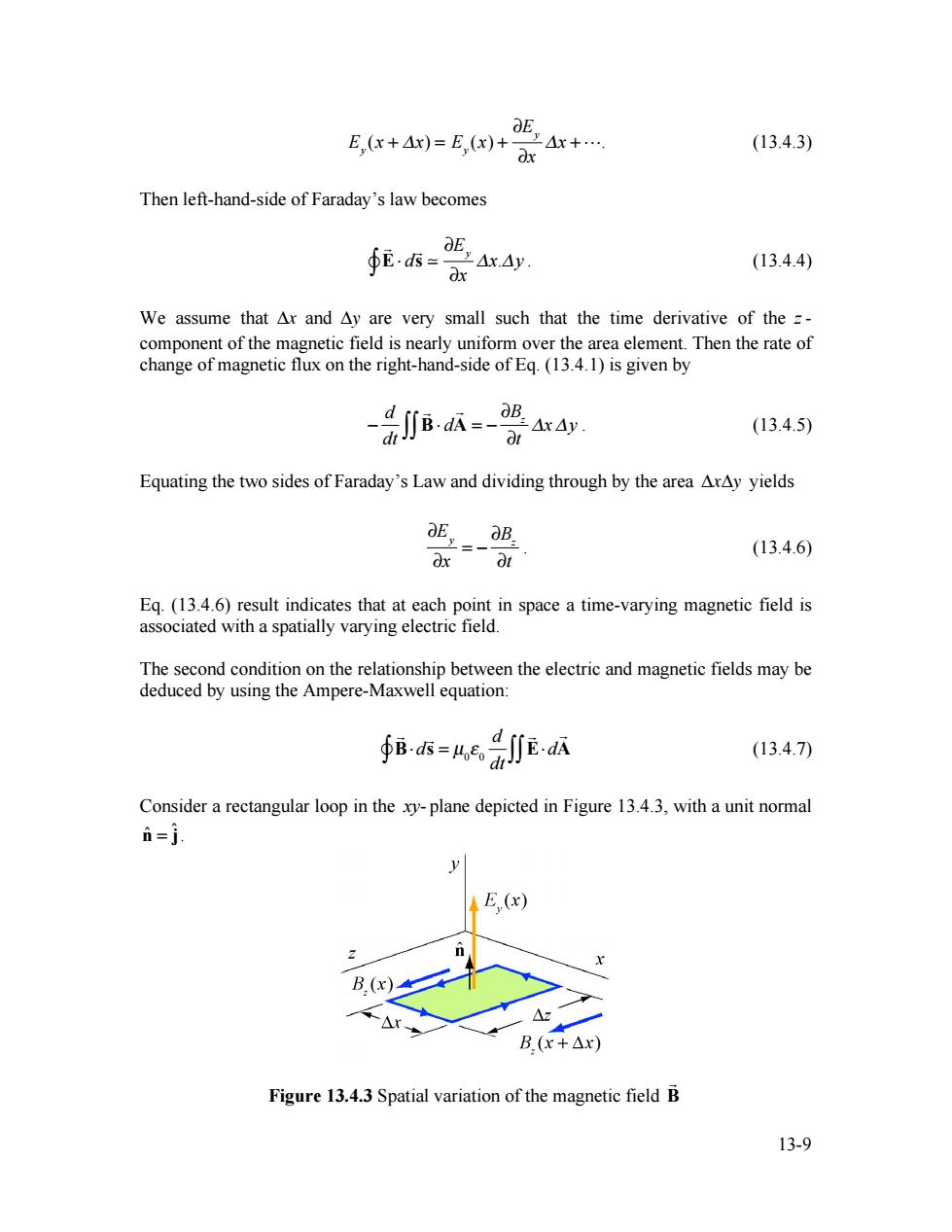
aEAx+… E.(x+Ax)=E,(x)+x (13.4.3) Then left-hand-side of Faraday's law becomes ∮Es= E2△xAy (13.4.4) Ox We assume that Ar and Ay are very small such that the time derivative of the = component of the magnetic field is nearly uniform over the area element.Then the rate of change of magnetic flux on the right-hand-side of Eq.(13.4.1)is given by s=- B△x△y, (13.4.5) Equating the two sides of Faraday's Law and dividing through by the area AxAy yields (13.4.6) Eq.(13.4.6)result indicates that at each point in space a time-varying magnetic field is associated with a spatially varying electric field. The second condition on the relationship between the electric and magnetic fields may be deduced by using the Ampere-Maxwell equation: B西=4气Ea (13.4.7) Consider a rectangular loop in the xy-plane depicted in Figure 13.4.3,with a unit normal n=j. E,(x) B.(x) △X 42 B(x+△x) Figure 13.4.3 Spatial variation of the magnetic field B 13-9
13-9 E y (x + !x) = E y (x) + "E y "x !x +!. (13.4.3) Then left-hand-side of Faraday’s law becomes ! E! d ! s "" # #E y #x $x.$y . (13.4.4) We assume that !x and !y are very small such that the time derivative of the z - component of the magnetic field is nearly uniform over the area element. Then the rate of change of magnetic flux on the right-hand-side of Eq. (13.4.1) is given by ! d dt ! B" d ! ## A = ! $Bz $t %x %y . (13.4.5) Equating the two sides of Faraday’s Law and dividing through by the area !x!y yields !E y !x = " !Bz !t . (13.4.6) Eq. (13.4.6) result indicates that at each point in space a time-varying magnetic field is associated with a spatially varying electric field. The second condition on the relationship between the electric and magnetic fields may be deduced by using the Ampere-Maxwell equation: ! B!d ! s = µ0 " 0 d dt "# ! E!d ! ## A (13.4.7) Consider a rectangular loop in the xy- plane depicted in Figure 13.4.3, with a unit normal ˆ nˆ = j. Figure 13.4.3 Spatial variation of the magnetic field B !
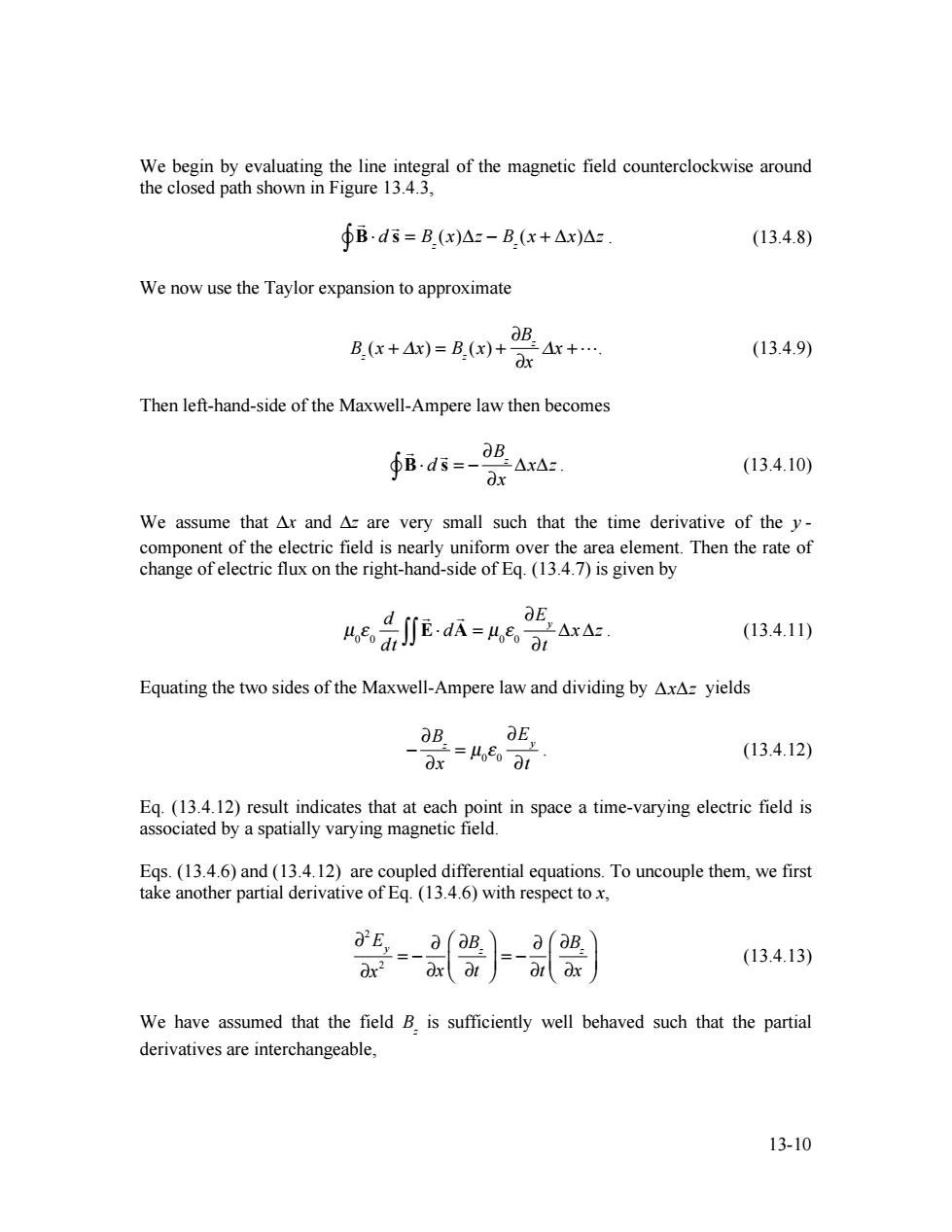
We begin by evaluating the line integral of the magnetic field counterclockwise around the closed path shown in Figure 13.4.3, ∮B-ds=B.(x)Az-B(+△x)A:. (13.4.8) We now use the Taylor expansion to approximate a B.(x+Ax)=B.(x)+ 三△x+… (13.4.9) O Then left-hand-side of the Maxwell-Ampere law then becomes 6B.d3=-O8 △x△z」 (13.4.10) dx We assume that Ax and Az are very small such that the time derivative of the y- component of the electric field is nearly uniform over the area element.Then the rate of change of electric flux on the right-hand-side of Eq.(13.4.7)is given by .AxAz. A品E-=e (13.4.11) Equating the two sides of the Maxwell-Ampere law and dividing by AxAz yields B.=Ho t E V (13.4.12) Ox Eq.(13.4.12)result indicates that at each point in space a time-varying electric field is associated by a spatially varying magnetic field. Egs.(13.4.6)and(13.4.12)are coupled differential equations.To uncouple them,we first take another partial derivative of Eq.(13.4.6)with respect to x, a=arar arl ax a∂B (13.4.13) We have assumed that the field B is sufficiently well behaved such that the partial derivatives are interchangeable, 13-10
13-10 We begin by evaluating the line integral of the magnetic field counterclockwise around the closed path shown in Figure 13.4.3, ! B! d ! s "" = Bz (x)#z $ Bz (x + #x)#z . (13.4.8) We now use the Taylor expansion to approximate Bz (x + !x) = Bz (x) + "Bz "x !x +!. (13.4.9) Then left-hand-side of the Maxwell-Ampere law then becomes ! B! d ! s "" = # $Bz $x %x%z. (13.4.10) We assume that !x and !z are very small such that the time derivative of the y - component of the electric field is nearly uniform over the area element. Then the rate of change of electric flux on the right-hand-side of Eq. (13.4.7) is given by µ0 ! 0 d dt ! E" d ! ## A = µ0 ! 0 $E y $t %x %z . (13.4.11) Equating the two sides of the Maxwell-Ampere law and dividing by !x!z yields ! "Bz "x = µ0 # 0 "E y "t . (13.4.12) Eq. (13.4.12) result indicates that at each point in space a time-varying electric field is associated by a spatially varying magnetic field. Eqs. (13.4.6) and (13.4.12) are coupled differential equations. To uncouple them, we first take another partial derivative of Eq. (13.4.6) with respect to x, !2 E y !x 2 = " ! !x !Bz !t # $ % & ' ( = " ! !t !Bz !x # $ % & ' ( (13.4.13) We have assumed that the field Bz is sufficiently well behaved such that the partial derivatives are interchangeable